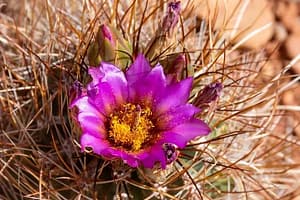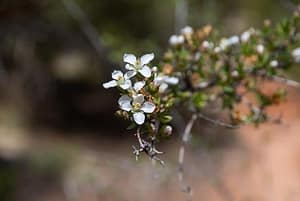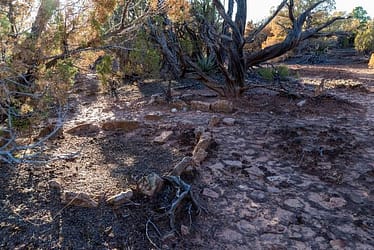Finding Archaeology in Bears Ears
- Tom Kratsch
- January 25, 2023
- Things To Do
Words and photos: Jan Noirot
Rounding the corner in the bottom of this shallow and obscure canyon, I happen to look up from my plodding feet. Wow! I looked up at just the right time! There is a tiny little stone wall chinked by adobe. It has a door, sits about ten feet above the drainage, and is built right in with some beautifully scalloped sandstone. Perhaps it is a granary, perhaps it is a safe sleeping place for the kids. Pictures of life at this place fill my imagination. The fires, the games, the home-cooked meals…
This is part of the magic of exploring the wilderness. Finding little treasures in the middle of nowhere that seem like they are discoveries all your own. Picturing the life of a stranger who lived there one thousand years before is mind boggling, and a little romantic.
These sites are one of the main reasons for the creation of Bears Ears National Monument, and one of the main reasons I keep exploring here. I am lucky to live nearby and find sites like this one, seldom seen and not crowded. But can the average visitor, who only has a few precious days of vacation, experience the same delights? Yes!
First, the archaeology of Bears Ears is abundant and significant. Someone told me that they thought there were hundreds of sites per square mile—at the time I laughed. I had just been down a canyon reputed to have many sites and my husband and I thought it was a dud. Now, however, I agree. We recently drove down that same canyon and could not stop pointing at things—steps, walls, petroglyphs, and fallen towers.

Second, one must learn what to look for. Or, perhaps, it is not what to look for, but how to look for it. I have seen this behavior in myself and others, ways to see things…or miss them!
Third, let go of social media expectations. My daughter came home from college one spring break with a half dozen friends in tow. We took them out to Natural Bridges National Monument. They spent more time posing and making faces in front of the sign than they did noticing the world’s second largest natural bridge a quarter mile behind them.
Fourth, be open to new sights. On one trip, a professional photographer from the East Coast hired me to take him to a famously photogenic cliff dwelling. He had a high-end camera and specially packed lenses and tripod. It was spring, the cliff roses were scenting, the claret cup cactuses were opening their deep red blooms, the canyon wrens were sending forth my favorite bird song, and rain had left behind not only pools, but brilliant clear colors. I offered up various scenes to this photographer, who I thought might not know what pictures he could take in Utah in the springtime. He wanted nothing of it, but sped on down the trail, where he spent an hour and a half with the tripod in the same spot in front of the cliff dwelling. He got his shot, but I kept wondering what other delights he could have enjoyed.


Fifth, no more “I’ve already seen that.” I’ve said that. Hundreds of times. I say it no longer here in Bears Ears country. I can’t begin to count the number of times that a change in lighting or a change of season has revealed a doorway in the face of a cliff. Or a petroglyph on a rock face. Or some stones in the sand that are spaced and make a rectangle or oval. Those are either kilns for making pottery, or caches for storing food, or even the base of an archaic pit house. Those sites are all over Bears Ears in all kinds of terrain—sand, drainages, alcoves, parking areas, popular places, and remote areas. There is a scruffy little canyon out my back door that we’ve walked hundreds of times to stay fit and give the dogs some exercise. Most times, my husband or I will come back talking about a new discovery.

And finally, slow down. Physically. Mentally. Recently, the stars aligned so that my husband and I could get down a canyon to a site named for a famous pictograph. It had been on my radar for years. The problem? We had a time constraint on the back end and the canyon was rough and steep. When we arrived, I scanned the sandstone walls, seeing some amazing, unusual, and rare rock art, all the while wondering if we would make it out in time. Yep, you got it: we didn’t find the specific pictograph that we came to see in the first place. I also didn’t enjoy what I did see as much as I could have. This was one of those hikes where we were faster going up than we were coming down, so I needn’t have worried at all. Like so many things, relax and take time to process and appreciate what you see. To quote a friend: “There are no bad hikes in Bears Ears country.”

Visitation Notes
Where is Bears Ears National Monument? It’s in the Four Corners region, in southeastern Utah, south of Moab. According to the Bureau of Land Management website, Bears Ears National Monument protects cultural, physical, social, biological, historic, and scientific objects. The BLM and the USDA Forest Service jointly manage the monument with the expertise and traditional and historical guidance of Tribal Nations through the Bears Ears Commission. The key to visiting Bears Ears with respect is to know before you go. That means doing your research and understanding which areas are safe and accessible, which areas require special vehicles or equipment, and which areas require permits. For visitors setting up a base camp at Bluff Dwellings Resort and Spa, check with their knowledgeable staff or guides at Wild Expeditions for ideas and tour information. The Bears Ears Visitor Center in Bluff is a great local resource as well.


